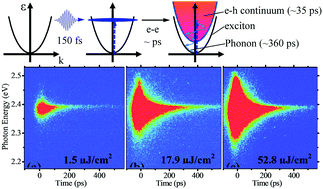Hot electron–hole plasma dynamics and amplified spontaneous emission in ZnTe nanowires
Abstract
Key to optimizing and tailoring the optoelectronic properties of semiconductor nanostructures for practical applications is a clear understanding of their carrier interactions and recombination dynamics. Herein, the electron–hole (e–h) plasma dynamics and the electron–phonon coupling interactions in zincblende ZnTe nanowires (NWs) were systematically investigated by time-resolved photoluminescence (TRPL) spectroscopy over a wide range of lattice temperatures (4–300 K) and pump densities. Following intense, non-resonant femtosecond (fs) laser pulse excitation, the excited carriers thermalize to quasi-equilibrium distribution through carrier–carrier and carrier–phonon scattering within a few picoseconds. The peak temperature of the hot electron gas (Te0) is much higher than the lattice temperature and increases sub-linearly with the pump fluence. The hot electron gas thermalizes in two characteristic carrier density-dependent regimes – i.e., within 35 ps under high carrier densities (e–h plasma) while persisting to 360 ps under low carrier densities (exciton). Temperature-dependent studies of the ZnTe NWs revealed that the acoustic phonons play a significant role in the cooling of the hot e–h plasma in these NWs and the emission band broadening arises from the interplay of the contributions from crystal imperfections, LA and LO phonon scattering and most importantly, from the hot carrier thermalization. For demonstration, e–h plasma-amplified spontaneous emission in ZnTe NWs at room temperature by one- and two-photon excitation was realized. The results provide new insights into carrier interactions and recombination dynamics of ZnTe NWs and highlight their potential for high-efficiency e–h plasma light emitters, sensors and in plasma photochemotherapy.



 Please wait while we load your content...
Please wait while we load your content...